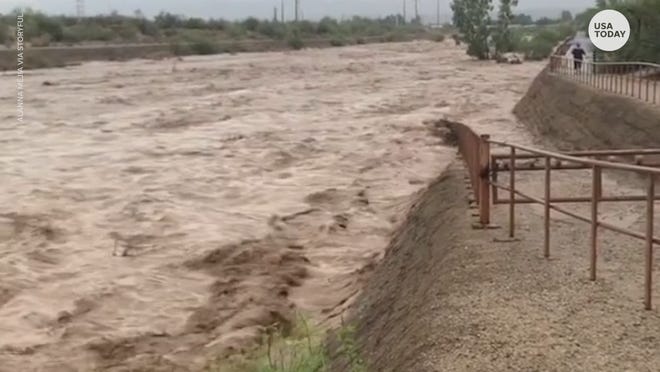SAN FRANCISCO – Western states besieged by numerous forest fires could face a new threat this week as thunderstorms loom and the possibility of flash floods increases.
The National Weather Service said the storms are expected to hit the western states, particularly the area from the Great Basin to the Rocky Mountains, and could help put out some fires but not bring relief to drought-stricken California.
“Heavy rainfall from monsoon activity will continue the potential for flash floods, especially in complex terrain, burn scars and urban areas,” the weather service said in those regions.
The first major manifestation of storm danger came on Sunday when mudslides “severely damaged” Interstate 70 in Glenwood Canyon, Colorado from heavy rainfall, blocking it with piles of boulders and logs, state transportation officials said.
Lanes in both directions of the freeway, a major transportation corridor between the Rocky Mountains and the west coast, remained blocked by debris poured from the scars of wildfire in the Grizzly Creek area last year.
Areas left sparse vegetation by forest fires across the west are particularly vulnerable to flash floods when hit by heavy rainfall. Parts of Nevada, Utah, Colorado, New Mexico, Idaho, Washington and Montana are under flood protection.
Double-edged sword:Southwest monsoon rains bring relief from drought – but also dangerous floods
This was the most active monsoon season since 2015, in contrast to the uneventful season last year. The large influx of rainfall has been a boon to parched states like New Mexico and Arizona – Tucson recorded its wettest July in history with 8.06 inches of rain, nearly four times the norm – but it also had tragic consequences. At least five people died from floods, and several more are missing.
AccuWeather chief meteorologist Alex Sosnowski said that unlike last year when the monsoon high pressure area was built in the west and blocked the flow of moisture from the Gulf of Mexico, this year it was farther east over the Rocky Mountains and plains.
“The clockwise circulation around the high draws moisture from the Gulf of Mexico and the Gulf of California to the southwest,” said Sosnowski.
That in turn feeds the downpours, but they haven’t reached Oregon or California, where two of the country’s biggest wildfires are burning, if not as wild as the days before.
Firefighters in Oregon reported progress in the fight against the bootleg fire, the largest in the country at more than 646 square miles in the remote southern part of the state. Containment increased from 56% on Saturday to 74% on Sunday.
“This reflects several good days of work on site, during which the crews were able to strengthen and build additional security lines,” said spokesman Al Nash.
Authorities in Northern California’s Butte and Plumas counties have canceled evacuation orders near another major fire, the Dixie Fire, that charred more than 388 square miles in Bergen, where 42 homes and other buildings were destroyed. The fire was 33% contained on Sunday, but authorities warned that unpredictable winds and extremely dry fuels keep the risk of flare-ups high.
Dry conditions and high winds also made dangerous fire conditions in Hawaii, where fast moving wildfire grew to 62.5 square miles on the Big Island, triggering evacuation orders.

The outbreak of fires in much of the American West has contaminated the air in much of the country, reaching the east coast and causing air quality warnings in parts of the West and Midwest, including the northern Rockies, on Sunday. Canadian forest fires also led to pollution warnings in Wisconsin, Minnesota, and Iowa.
Forest fires emit huge amounts of microscopic smoke particles that researchers say are harmful if inhaled and can have both immediate and long-term health effects. Children, the elderly and people with previous illnesses are particularly at risk.
On Friday, President Joe Biden and Vice President Kamala Harris met with governors from California, Idaho, Minnesota, Montana, Oregon, Washington and Wyoming, the second of its kind, to discuss fire safety and fire fighting measures.
“Our resources are already exhausted to keep up,” said Biden. “We need more help”
On the same day, California Governor Gavin Newsom signed a proclamation to incentivize large companies to conserve energy while the state prepares for potential power outages due to the high heat conditions. Drought has minimized hydropower output and the state could face 3,500 megawatts of shortage on hot days.

Contributors: Elinor Aspegren and Jeanine Santucci, USA TODAY; The Associated Press
